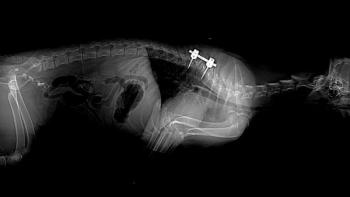
Fear-Free: A veterinary neurologists perspective
What happens in the amygdala stays in the amygdala.
Dr. Rick LeCouteurRichard LeCouteur, DVM, PhD, DACVIM (neurology), DECVN, a veterinary neurologist at the University of California, Davis, School of Veterinary Medicine, has been friends with Marty Becker, DVM, for years. So when Becker invited him to be a part of the Fear-Free event at the CVC in Washington, D.C., this year, he jumped at the chance. The movement has become a passion for him as well.
“I remember early on in my practice days when a dog would try to bite me, I'd use force,” LeCouteur told the crowd in D.C. “I never felt good about that. Never ever. I dominated the animal however I could. I got over that very quickly because I was feeling bad. I wasn't enjoying my job.”
The theme of LeCouteur's presentation was how everyone in the veterinary clinic needs to acknowledge that animals feel fear. He compared it with the idea that the veterinary field used to think animals didn't feel pain the same way people do. But changes in the last 50, even 20 years have made a world of difference in this area.
“Everybody in the room embraces the concept that animals are able to perceive pain,” he said. “Nobody argues that. We go to lectures on analgesics and different medications that control pain.” LeCouteur thinks admitting that animals can be fearful-and then doing something to minimize it-is the next step to take for the good of all patients.
A laughing matter? Dr. Rick LeCouteur, a neurologist at UC Davis, gave a memorable presentation during CVC Washington, D.C., keeping the audience chuckling while addressing a very serious topic. LeCouteur will also be speaking at CVC San Diego Dec. 5.To help his audience view the topic from a neurologist's perspective, LeCouteur described the structures in the brain that lead to feelings of fear. The amgydala is the most to blame, he says, as this is the region where the memory of emotion is housed, particularly bad emotion.
“So the pet went to the vet, and the vet stuck a thermometer up the pet's bum. That's in the amygdala forever,” said LeCouteur. “And that's what we do: ‘Hi little puppy.' Stroke him down the back. Thermometer.
“It doesn't matter what an animal's amygdala remembers. You can't change what's in the amygdala,” LeCouteur continued.
Don't ever call Dr. LeCouteur an amygdala!
During his presentation at the CVC in Washington, D.C., LeCouteur had the audience in stitches when discussing the annoying nature of the amygdala. He compared it to the one person at the party who always reminds of you of that one time something bad happened.
So is a patient's case hopeless once the damage has been done? The animal is forever frightened in your clinic because the amygdala tells it so? All is not lost in the least, according to LeCouteur. “The cortex can change its mind through conditioning and experience, and it can override the amygdala's memory,” he said. “Fear extinctions are stored in the cortex.”
Fear-Free practice techniques are all about overriding fearful memories stored in the brain. Some measures LeCouteur adopted early on in his practice: yoga mats on the stainless steel examination tables to provide sure footing, gurneys just 6 inches off the ground so the patient's point-of-view isn't so drastically different than normal and a nonslip entryway for clients and patients.
If you think your practice is already taking lots of the Fear-Free measures, think again, said LeCouteur. “When I first heard about this, I thought, ‘We're doing that!' But we weren't doing half of it. It's got to be a conscious effort. Everybody has to make the commitment. Everybody has to police one another, not in an aggressive sense but help one another and say, ‘Maybe it would be better if we did it this way.'”
If you think you are ready to start in earnest, LeCouteur has one caution: “Once you take the step to use these techniques and strategies that we propose are important in a Fear-Free practice, you have to also take the responsible step of never breaking the rules. For example, you have to speak softly always. It's hard to speak softly when you've just been scratched or whatever, but you have to.”
Because you are reprogramming your patient's brain to find the visit more pleasurable, any adverse interactions that occur while using those measures can backfire and get the animal to associate that measure with a fearful experience. But don't let this caution keep you from taking up this cause. LeCouteur summed up the importance of this new movement: “Embrace Fear-Free practices. Help us improve what we do. Please don't say, ‘Oh, we're already doing it all.' Let's get this movement going. It'll help veterinary medicine. Veterinarians know more about Fear-Free than anyone. It's our territory. We own that. And it is the future.”
Want to hear LeCouteur's complete presentation in person? Never fear! He will again be joining Becker as well as Lisa Radosta, DVM, DACVB, at the
Mindy Valcarcel is the editor of Veterinary Medicine and Medicine Channel Director for dvm360.com.
Newsletter
From exam room tips to practice management insights, get trusted veterinary news delivered straight to your inbox—subscribe to dvm360.






